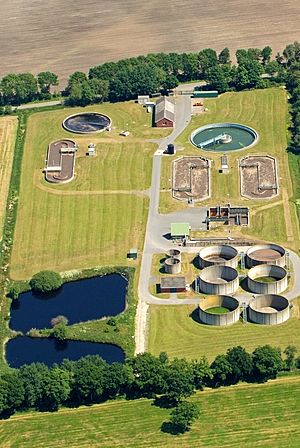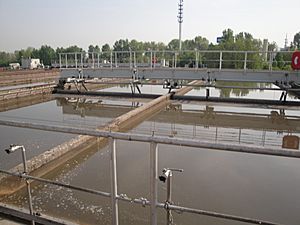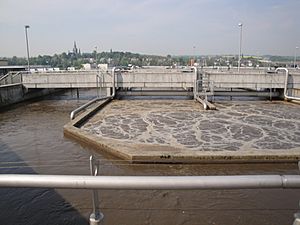Wastewater treatment facts for kids

Wastewater treatment is a special process that cleans dirty water, called wastewater. It removes harmful things, known as contaminants, from this water. After treatment, the clean water, called effluent, can safely go back into the water cycle. This means it can return to rivers, lakes, or even be reused for different purposes. When water is reused, it's called reclaimed water.
This cleaning process happens at a special place called a wastewater treatment plant. There are different kinds of plants for different types of wastewater. For water from homes and cities (also called sewage), the plant is known as a sewage treatment plant. Water from factories, called industrial wastewater, might be cleaned at its own special plant or at a sewage treatment plant after some first steps. Other types of plants clean water from farms or from landfills.
During treatment, common steps include separating solids from liquids, using natural processes with tiny living things, or using chemicals. A main leftover from this process is a thick mud called sludge, which is also treated. Sometimes, if certain methods are used, a gas called Biogas can also be made.
The main goal of cleaning wastewater is to make sure it can be safely put back into the environment or reused. Before any water is treated, people decide how it will be used or where it will go. This helps them choose the best cleaning method. Bangladesh recently opened a very large sewage treatment plant that can clean five million liters of wastewater every day.
The term "wastewater treatment" is often used to mean "sewage treatment."
Types of Cleaning Plants
Wastewater treatment plants are often named after the kind of dirty water they clean. Many different methods can be used to clean wastewater, depending on what's in it and how dirty it is. The cleaning steps can involve physical methods, chemical reactions, or biological processes using tiny organisms.
Here are the main types of wastewater treatment plants:
- Sewage treatment plants (for water from homes and cities)
- Industrial wastewater plants (for water from factories)
- Agricultural wastewater plants (for water from farms)
- Leachate treatment plants (for water from landfills)
Sewage Treatment Plants
Sewage treatment plants clean wastewater from homes, schools, and businesses. This water, called sewage, contains things like human waste, food scraps, soaps, and chemicals from cleaning. The main goal is to remove harmful substances and disease-causing germs before the water goes back into nature.
The cleaning process usually has several stages. The first stage removes large solids and grease. The second stage uses tiny living things, like bacteria, to break down smaller pollutants. Sometimes, there's a third stage to remove nutrients like nitrogen and phosphorus. These nutrients can cause problems if too much gets into rivers and lakes.
After all the cleaning, the treated water is usually disinfected to kill any remaining germs. This often involves using chlorine or ultraviolet light. The cleaned water is then released into a river, lake, or ocean, or it can be reused for things like watering parks or crops.
Industrial Wastewater Plants
Industrial wastewater plants clean water that comes from factories and industries. This water can be very different depending on what the factory makes. For example, a food factory's wastewater will be different from a chemical plant's wastewater.
Because industrial wastewater can contain many different types of pollutants, these plants often use special cleaning methods. Sometimes, factories will do some cleaning themselves before sending their wastewater to a city's sewage plant. This helps protect the city's plant from unusual or very strong pollutants.
Agricultural Wastewater Plants
Agricultural wastewater plants clean water that comes from farms. This water can contain things like animal waste, leftover fertilizers, and pesticides. If this water isn't cleaned, it can harm rivers and lakes by adding too many nutrients or chemicals.
These plants use methods to remove these farm-related pollutants. This helps protect the environment and keeps water sources clean for people and wildlife.
Leachate Treatment Plants
Leachate is a liquid that forms when rain or other water trickles through waste in a landfill. As it passes through the trash, it picks up many harmful substances. Leachate treatment plants are designed to clean this very dirty liquid.
These plants use various methods to treat leachate. They might use biological processes, special filters, or even activated carbon to remove the pollutants. The goal is to make the leachate safe before it's released into the environment.
How Wastewater is Cleaned
The cleaning of wastewater involves different steps. These can include physical steps, like letting things settle, or biological steps, like using tiny living things to break down waste. Some types of wastewater need very specific cleaning methods.
In simple terms, most wastewater is cleaned by separating the solid bits from the liquid. This is often done by letting the solids sink to the bottom. As the water gets cleaner, more dissolved materials turn into solids, which can then be removed. This makes the water purer step by step.
Separating Things Out
This step removes impurities by moving them into a non-water part. This separation can happen at different points in the cleaning process to get rid of solids that form during other steps. For example, grease and oil can be collected and sometimes used as fuel. The solid waste, called sludge, often needs to have its water removed. How this dried sludge is handled depends on what impurities it contains.
Settling Solids
Heavy things like stones, grit, and sand can be removed from wastewater by gravity. This happens when they are heavy enough to sink through the water. Special channels are designed to slow the water down just enough so that grit settles, but lighter things keep moving to the next cleaning stage.
This settling process is a very important first step in cleaning sewage. Here, it's done in large tanks called "primary settling tanks." It's also used for many other types of wastewater. Solids that are heavier than water will collect at the bottom of these quiet settling tanks. More advanced tanks, called clarifiers, also have tools to skim off floating grease, like soap scum, and other floating solids, like feathers.
Biological and Chemical Cleaning
Oxidation
Oxidation helps reduce the amount of oxygen that wastewater would use up if it were released untreated. It can also make some impurities less harmful. The second stage of cleaning uses oxidation to change organic compounds into carbon dioxide, water, and biosolids (solids made from living things). Chemical oxidation is also widely used to kill germs.
Biological Oxidation (Second Stage Cleaning)
The second stage of cleaning, called secondary treatment, removes dissolved and very fine solid organic matter from wastewater. This is usually done using helpful bacteria and other tiny living things. These microorganisms eat the pollutants in the water. They grow and multiply, forming a sludge that can then be removed from the water. This process greatly reduces the amount of harmful material in the wastewater.
Chemical Oxidation
Advanced chemical oxidation processes are used to remove some very tough pollutants that remain after biological cleaning. Disinfection, which kills bacteria and other harmful germs, is done by adding chemicals like ozone or chlorine to the wastewater. These chemicals break down complex pollutants into simpler, harmless substances like water, carbon dioxide, and salts.
Anaerobic Treatment
Anaerobic wastewater treatment processes are also used to clean industrial wastewater and biological sludge. These methods work without oxygen. For example, systems like UASB (Upflow Anaerobic Sludge Blanket) are often used.
Final Cleaning (Polishing)
Polishing refers to extra cleaning steps that happen after the main treatment methods. These are sometimes called "fourth stage" treatments. They can also be used on their own for some industrial wastewater.
One method is Carbon filtering, which uses activated carbon to absorb any remaining pollutants and impurities. Filtering water through sand or fabric is a common way to do this in city wastewater plants. Sometimes, chemicals are used to adjust the water's pH level, making it less reactive after chemical oxidation.
See also
- List of largest wastewater treatment plants
- List of wastewater treatment technologies
- Water treatment
Images for kids





